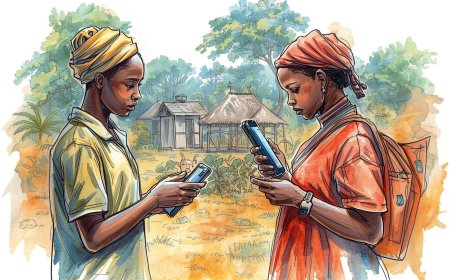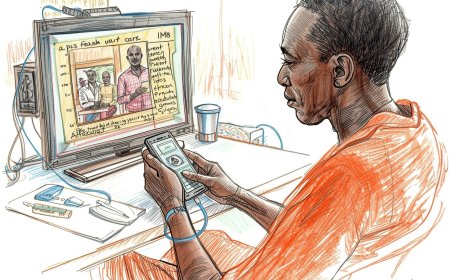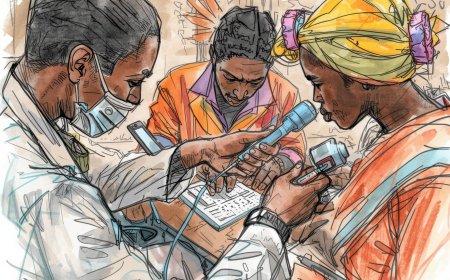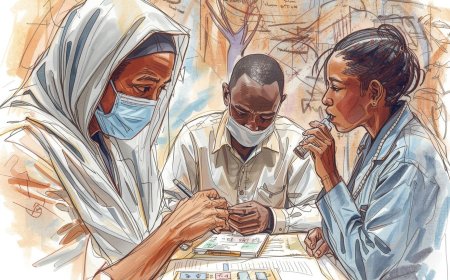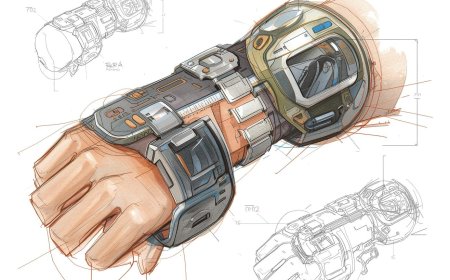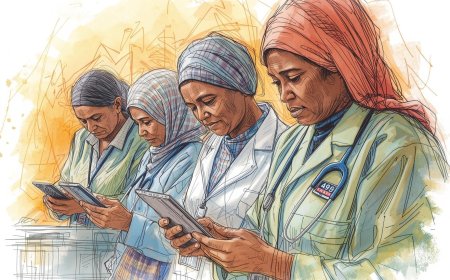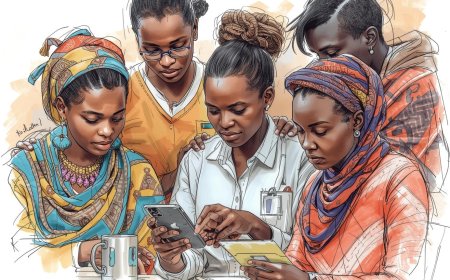Incentives and Retention Strategies for Community Health Workers Using Digital Platforms in Africa
Sustaining community health worker (CHW) programmes that use mobile apps requires more than good software — it needs well-designed incentive and retention strategies. This APA-style article for an African audience summarises evidence on what motivates CHWs, explains financial and non-financial incentives suited to digital programmes (including mobile payments, performance pay, recognition, career pathways, and supervision), and provides practical implementation guidance, monitoring metrics, and a 12-point operational checklist. Recommendations are grounded in global reviews and African implementation experience.
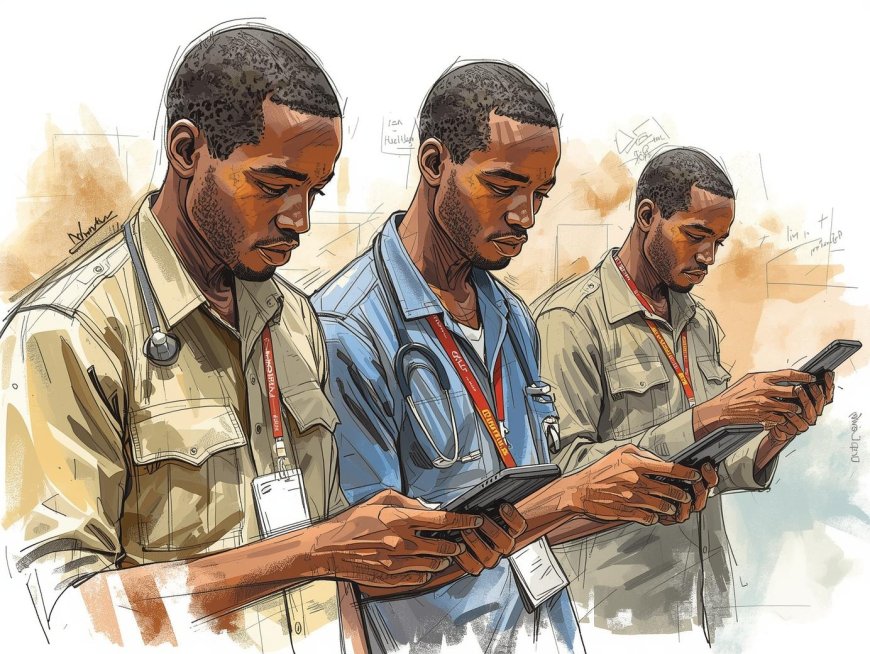
Abstract
Community health workers (CHWs) are essential for primary health coverage across Africa. As programmes scale digital tools (mobile apps for case management, reporting, training, and referral), keeping CHWs motivated and retained becomes a key sustainability challenge. This article synthesises evidence on incentive design and retention for CHWs in low- and middle-income countries, highlights digital-specific opportunities and risks (mobile money, timeliness of payments, gamification, dashboards), and offers operational guidance—contracts, supervision, blended incentives, monitoring metrics, and a 12-step checklist—for implementers, health ministries, and funders. Recommendations draw on systematic reviews, WHO experience with digital payments, and African implementation studies. PMC+2World Health Organization+2
Introduction
Community health worker programmes depend on consistent motivation and low attrition. CHWs are frequently recruited from communities and receive mixed packages of compensation—volunteer stipends, performance bonuses, non-financial recognition, and supervision. When digital platforms enter the picture, they change both what can be measured (performance data, timeliness) and what can be delivered (mobile payments, in-app learning, dashboards). This creates new opportunities to design incentive systems that are timely, transparent, and scalable — but also new risks (payment delays, inequitable gamification, data-driven pressure). Successful programmes marry sound incentive design with robust digital operations and human-centered supervision. BioMed Central+1
What the evidence says — core findings
-
Mixed packages outperform single incentives. Reviews show that combinations of financial and non-financial incentives (predictable pay + training + supervision + community recognition) are more effective for CHW performance and retention than any single incentive type. Predictability and fairness matter as much as nominal amounts. PMC+1
-
Timeliness and predictability of payments are critical; digital payments can help — but only when reliable. WHO and implementation reports document large-scale gains in retention and motivation when payments are digitised and reliably delivered. Conversely, digital payments that are delayed, incomplete, or expensive to withdraw reduce motivation and may harm retention. Implementers must design for local cash-out realities. World Health Organization+1
-
Non-financial incentives (career pathways, supervision, recognition) strongly influence long-term retention. Opportunities for skill development, certification, clear career ladders, and community respect produce durable commitment that pure cash can’t buy alone. BioMed Central+1
-
Performance-based pay can raise activity but risks gaming and exclusion if poorly designed. Large, well-targeted incentives can boost effort, but small or unpredictable bonuses may backfire. Data quality, fair targets, and safeguards against perverse incentives are essential. PMC
-
Supervision and workload management remain central. Digital platforms can enable better supervision (dashboards, red-flag alerts) and targeted mentoring, both of which improve CHW satisfaction and retention when coupled with respectful management. Frontiers
Types of incentives & how digital platforms change them
Financial incentives
-
Regular stipends / salaries: predictable monthly payments (ideally via mobile money) provide income security. Digital payroll reduces leakage and creates payment records for transparency. But ensure reliable network/cash-out points to avoid frustration. World Health Organization+1
-
Performance-based payments (PBP): bonuses tied to verified outputs (e.g., number of completed home visits verified by GPS + supervisor sign-off). Use conservative targets and audit rules to limit gaming. PMC
-
In-kind support & cost reimbursement: airtime/data bundles, bicycles, protective equipment, or travel reimbursements delivered or tracked via apps reduce barriers to work. Mobile airtime top-ups can be automated. Frontiers
Non-financial incentives
-
Recognition & career ladders: digital badges, leaderboards, and certificates (tied to demonstrable competencies) can motivate — but must be linked to meaningful advancement (training, formal role, stipend increases). PMC
-
Training & professional development: in-app microlearning, refresher modules, and accredited courses increase skills and make CHW roles more attractive. Digital learning lowers cost and supports continual growth. Last Mile Health
-
Supervision and supportive feedback: dashboards that enable supervisors to provide timely coaching, coupled with routine field visits, show CHWs they are supported and valued. Frontiers
Social & community incentives
-
Community recognition: public certificates, community meetings, or formal selection processes reinforce social status and legitimacy — a strong retention lever. BioMed Central
Digital-specific design considerations (practical guidance)
-
Design payments for reliability and local cash-out. Before switching to mobile money, map agent networks, transaction fees, and offline fallback options. Delayed or partial digital payments demotivate CHWs more than modest predictable cash. Include reconciliation and help desks. World Health Organization+1
-
Use verified data to trigger incentives — but validate. Tie PBPs to multi-source verification (GPS + photo + supervisor sign-off) and sample audits to reduce fraud. Build error-handling flows so legitimate work isn’t penalised because of connectivity glitches. PMC+1
-
Prefer predictable base pay + small performance top-ups over volatile pay-only models. Predictability reduces attrition; modest PBPs can boost activity if transparent and fair. PMC
-
In-app recognition should be meaningful and equitable. Leaderboards and badges work if rewards are attainable and aligned with service quality, not just quantity. Publish transparent criteria. PMC
-
Protect CHWs from surveillance burnout. High-frequency tracking without feedback or support creates stress. Use dashboards to coach, not punish; combine automated alerts with human follow-up. Frontiers
-
Design for low-bandwidth and offline use. Ensure the app stores evidence locally and syncs reliably; have fallback reporting channels for payment triggers so CHWs aren’t penalised for connectivity gaps. dp.malariaconsortium.org
Retention strategies that work (operational playbook)
-
Predictable compensation + transparent payment records. Even small predictable stipends lower attrition more than large irregular bonuses. Use digital payroll to provide proof of earnings for CHWs (helps household planning). PMC+1
-
Blended incentive packages. Combine base pay, in-kind support (data/transport), performance top-ups, and non-financial incentives (training, recognition). Tailor mix by geography and CHW profile. PMC
-
Clear career progression & accreditation. Create competency frameworks with badges and pathways to supervisory roles or formal employment. In-app learning modules feeding into recognised certification increase retention. PMC
-
Supportive supervision enabled by digital dashboards. Supervisors use data to prioritise visits, deliver coaching, and resolve problems quickly; regular human contact prevents isolation and burnout. Frontiers
-
Community engagement & legitimacy. Invest in community selection, public recognition events, and joint problem-solving forums to strengthen social embeddedness. BioMed Central
-
Responsive grievance and support mechanisms. Provide in-app reporting for payment issues and confidential channels for workload or safety concerns. Rapid resolution of grievances prevents erosion of trust in the system. PMC
-
Iterative, data-driven adjustments. Use weekly/monthly KPIs (see below) to detect early warning signs of demotivation and adapt incentives (e.g., extra support in low-performing locations). dp.malariaconsortium.org
Monitoring & evaluation: metrics you must track
-
Retention / attrition rate (monthly/annual) by cohort and region.
-
Payment timeliness: % payments delivered within X days of due date.
-
Payment completeness: % of CHWs receiving full stipend/top-up.
-
Activity metrics: visits completed per CHW per week (verified).
-
Data quality: % mandatory fields completed, sync frequency.
-
Supervisor contacts: number of coaching interactions per CHW per month.
-
CHW satisfaction & motivation: periodic short pulse surveys (in-app or by SMS).
-
Grievance resolution time: median time to resolve payment or safety issues. World Health Organization+1
Use simple dashboards and automated alerts for payment failures, sudden drops in activity, or sustained low supervision coverage.
Risks, trade-offs & mitigation
-
Risk: payment delays from digital systems. Mitigation: dual-channel fallback (cash pickup), reconciliations, and a dedicated helpdesk. PMC
-
Risk: perverse incentives or data gaming. Mitigation: multi-source verification, random audits, and design targets that reward quality as well as quantity. PMC
-
Risk: dependency on donor-funded stipends. Mitigation: phase-in co-financing, align incentives with government budgets, and demonstrate cost-effectiveness. Results for Development
-
Risk: inequity across geographies. Mitigation: contextualise incentive levels and ensure non-financial support is available in the hardest-to-serve areas. BioMed Central
12-Point Operational Checklist (ready to use)
-
Map local cash-out infrastructure and mobile-money partners before designing digital payroll. World Health Organization
-
Define a baseline predictable stipend (or salary) and keep it distinct from PBPs. PMC
-
Co-design performance targets with CHWs and supervisors; pilot and iterate. PMC
-
Automate small in-kind benefits (airtime/data) through the app. Frontiers
-
Build multi-factor verification workflows for PBPs (GPS/photo + supervisor sign-off). dp.malariaconsortium.org
-
Implement an easy in-app grievance/helpdesk flow with SLAs for resolution. PMC
-
Provide in-app microlearning and certificate pathways linked to tangible rewards. Last Mile Health
-
Create transparent reporting of payments and performance visible to CHWs. World Health Organization
-
Schedule regular supportive supervision (mix of remote + field visits). Frontiers
-
Monitor payment timeliness and retention KPIs weekly; trigger interventions for outliers. World Health Organization
-
Budget for device replacement, airtime, and operational payment costs (transaction fees). IQVIA
-
Plan transition to government financing or blended finance to reduce donor fragility. Results for Development
Case examples & lessons from Africa
-
WHO/Global initiatives on digital payments: WHO’s experience digitising payments for health workers across Africa shows positive effects on retention when payments are reliable and part of broader workforce support. Implementers emphasise mapping cash-out access and building reconciliation processes. World Health Organization
-
Operational reports from digital CHW platforms (e.g., upSCALE, Jamii ni Afya): These programmes highlight the value of in-app learning, supervisor dashboards, and automated airtime top-ups — but caution that payment delays and connectivity issues can quickly erode trust. dp.malariaconsortium.org+1
-
Research on payment modality preferences: Some studies show CHWs prefer cash where mobile networks or agent liquidity are poor; digital payments must therefore be implemented with attention to local realities to avoid demotivation. PMC
Conclusion
Digital platforms unlock powerful levers to incentivise and retain CHWs — timely mobile payments, automated in-kind support, in-app recognition, and supervisor dashboards. But technology alone is not a silver bullet. Predictability, fairness, supportive supervision, career pathways, and community legitimacy are the durable drivers of retention. Implementers should deploy blended incentive packages, design payment flows for local constraints, verify performance fairly, and monitor core KPIs to detect early problems. When digital incentives are built around human-centered governance and reliable operations, they help sustain CHW programmes that deliver essential health services across Africa. PMC+1
References
Kok, M. C., et al. (2014). Which intervention design factors influence performance of community health workers in low- and middle-income countries? Global Health Science & Practice. PMC
World Health Organization. (2024, February 9). Digital payments to health workers boost retention, motivation and impact. WHO. World Health Organization
Agarwal, S., et al. (2021). Understanding community health worker incentive preferences: A discrete choice experiment. Global Health Action / PMC. PMC
Wagaba, M. T., et al. (2024). Do cash or digital payment modalities affect community health worker performance and motivation? PMC Article. PMC
Owoyemi, A., et al. (2022). Digital solutions for community and primary health workers: Lessons from implementations in Africa. Frontiers in Digital Health. Frontiers
Malaria Consortium. (2022). Implementing a large-scale community digital health platform (upSCALE): learning paper. dp.malariaconsortium.org
Last Mile Health. (2024). Three digital health innovations helping community health workers deliver quality care. Last Mile Health. Last Mile Health
IQVIA. (2024). Digital health system maturity in Africa (white paper). IQVIA
What's Your Reaction?
 Like
0
Like
0
 Dislike
0
Dislike
0
 Love
0
Love
0
 Funny
0
Funny
0
 Angry
0
Angry
0
 Sad
0
Sad
0
 Wow
0
Wow
0
















